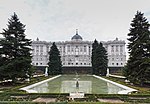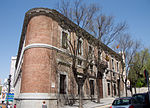Church of Santa Teresa y San José (Madrid)
AC with 0 elementsBien de Interés Cultural landmarks in MadridBuildings and structures in Argüelles neighborhood, MadridChurch buildings with domesRoman Catholic churches in Madrid

The Parish Church of Santa Teresa y San José (Spanish: Iglesia Parroquial de Santa Teresa y San José), also known as the National Temple of Santa Teresa de Jesús and Convent of the Discalced Carmelite Fathers (Templo Nacional de Santa Teresa de Jesús y Convento de los Padres Carmelitas Descalzos), is a Catholic church located in Madrid, Spain. The complex serves as a religious community residence, a nursing home and a parish church. It was declared Bien de Interés Cultural in 1995.
Excerpt from the Wikipedia article Church of Santa Teresa y San José (Madrid) (License: CC BY-SA 3.0, Authors, Images).Church of Santa Teresa y San José (Madrid)
Plaza de España, Madrid
Geographical coordinates (GPS) Address Phone number Nearby Places Show on map
Geographical coordinates (GPS)
| Latitude | Longitude |
|---|---|
| N 40.422356 ° | E -3.714914 ° |
Address
Parroquia de Santa Teresa y San José
Plaza de España 14
28008 Madrid (Moncloa-Aravaca)
Community of Madrid, Spain
Open on Google Maps











